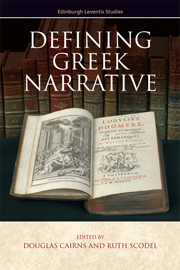Book contents
- Frontmatter
- Contents
- Preface
- Notes on Contributors
- 1 Introduction
- PART I DEFINING THE GREEK TRADITION
- PART II THE DEVELOPMENT OF THE GREEK TRADITION
- 6 Exemplarity and Narrative in the Greek Tradition
- 7 ‘Where do I begin?’: An Odyssean Narrative Strategy and its Afterlife
- 8 Some Ancient Views on Narrative, its Structure and Working
- 9 Who, Sappho?
- 10 The Creative Impact of the Occasion: Pindar's Songs for the Emmenids and Horace's Odes 1.12 and 4.2
- 11 Narrative on the Greek Tragic Stage
- 12 Stock Situations, Topoi and the Greekness of Greek Historiography
- 13 Heliodorus the Hellene
- PART III BEYOND GREECE
- Bibliography
- Index
11 - Narrative on the Greek Tragic Stage
from PART II - THE DEVELOPMENT OF THE GREEK TRADITION
Published online by Cambridge University Press: 05 September 2014
- Frontmatter
- Contents
- Preface
- Notes on Contributors
- 1 Introduction
- PART I DEFINING THE GREEK TRADITION
- PART II THE DEVELOPMENT OF THE GREEK TRADITION
- 6 Exemplarity and Narrative in the Greek Tradition
- 7 ‘Where do I begin?’: An Odyssean Narrative Strategy and its Afterlife
- 8 Some Ancient Views on Narrative, its Structure and Working
- 9 Who, Sappho?
- 10 The Creative Impact of the Occasion: Pindar's Songs for the Emmenids and Horace's Odes 1.12 and 4.2
- 11 Narrative on the Greek Tragic Stage
- 12 Stock Situations, Topoi and the Greekness of Greek Historiography
- 13 Heliodorus the Hellene
- PART III BEYOND GREECE
- Bibliography
- Index
Summary
This chapter sets out to look for what was distinctive about Greek practice in the staging of tragic stories. There is no doubt that this new art form of the late sixth and early fifth centuries was a highly original experiment, with no obvious model in other cultures, but of course the early dramatists did not have to start from scratch. The epic and lyric traditions offered them a great range of serious narratives which had already been shaped for performance, whether by rhapsodes or by choruses, and without this precedent it would be hard to imagine Attic tragedy having developed as quickly as it did into a genre of such richness, sophistication and popular appeal.
Once the early dramatists had taken the crucial step of representing imagined characters (particularly famous figures from the mythical past) as present here and now, enacting their stories before an audience as if for the first time, the dynamics of narrative must have needed reshaping to suit the new medium, and this is where we should be looking for creative experimentation. For example, when we consider the forms taken by narrative in tragedy there is no need to see them as determined by, or as hangovers from, epic practice, or to single out ‘messenger speeches’ as having a specially privileged status.
- Type
- Chapter
- Information
- Defining Greek Narrative , pp. 226 - 240Publisher: Edinburgh University PressPrint publication year: 2014



